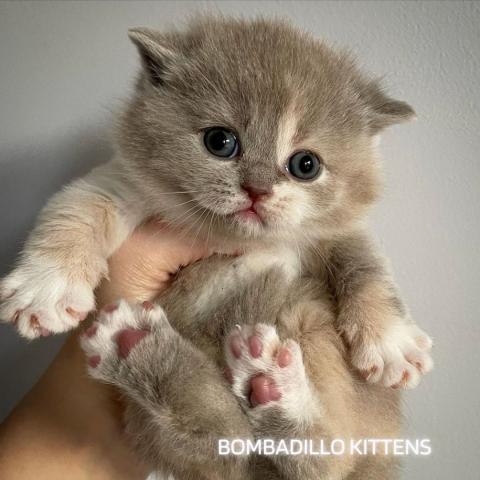Discover the calico British Shorthair kitten, and the genes that go into creating her!

Calico British Shorthair cats do make particularly cute little kittens, especially when they are super chunky (and most importantly healthy).
Calico British Shorthair appearance
Calico British Shorthairs are sometimes called tricolour cats. They are essentially tortie cats with the addition of white, so they are 3 colours:
- their base colour (black, blue, chocolate, lilac, cinnamon or fawn);
- red or cream; and
- white
Their base colour and cream/red appear in patches of colour across the cat, and the white usually presents itself as a standard bicolour pattern (face mask, tummy and paws become white).
Calico British Shorthair Genetics
Essentially a calico cat has its normal colour (black, chocolate, cinnamon etc). But on top of that the cat has a red gene from its mum. That makes a calico a tortie cat - a cat that has a non-red gene and a red gene. As a result, calico cats can only ever be female. Which is quite helpful when sexing kittens: any tortie kitten is a girl. Tortie cats are two colours, and the colours are randomly, finely stippled across the cat's coat.
Dilute Calico cats

Torties can come in any of the British shorthair colours: black, chocolate and cinnamon. The image above is a blue tortie kitten, sometimes referred to as a blue-cream. You can see how the cream is so finely stippled across her body that you can barely see it. If you look closely at the chin you can see a tiny patch of cream.
If the cat has two dilution genes, then black becomes blue, chocolate becomes lilac and cinnamon becomes fawn. The dilution gene is a clever little gene. It is a genetic mutation, which is totally harmless. It reduces the amount of pigment in the fur of the cat. So a blue cat is a black cat, with less pigment in each strand of fur, which makes it appear blue (grey).
When we write down the dilution genes, we represent them like this:
- dd = dilute, dilute. Also known as homozygous dilute. A cat with this genetic combination will always pass a dilution gene onto his or her offspring.
- DD = non dilute. Also known as homozygous non-dilute. A cat with this genetic combination will only ever have non-dilute coloured kittens.
- Dd = non-dilute, carrying the dilution gene. Also known as heterozygous dilute. A cat with this genetic combination could have non-dilute kittens and dilute kittens IF the other parent also has the dilution gene.
So that explains how we get torties in the various colours.
(homozygous dilution, represented as 'dd', whereas non dilute is represented as DD and non-dilute, carrying the dilution
Calico and the white spotting gene
The white spotting gene is responsible for the cat's bicolour pattern.
You can read more about bicolours and their genetics here.
But in the case of a tortie cat, the white spotting gene does something quite special. Not only does it put the white bicolour pattern on the cat, but it also makes the random stipples of blue/cream, lilac/cream etc become larger patches rather than fine stipples.
So that is how we end up with 'patchy' cats.
Calico or tricolour cats can come in any British Shorthair pattern. So it is even possible to have calico tabbies!
Find out if we have any kittens available.
We are expert British Shorthair breeders. We specialise in the more magical, unusual British Shorthairs but we do also get some of the more classic colours and patterns as well. A calico British Shorthair is always a very welcome and exciting addition when they arrive!